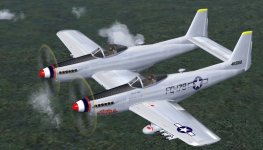Understood about the extra red band. Not so sure that your smaller nose art matches the photo though. Note how, on the photo, the top of the name almost touches the exhaust stacks, while the bottom almost reaches that little grill panel.
By ruining the shine I mean that a specular gloss will interfere with reflective textures and make them look like glossy gray at worse, or like glossy silver paint at best, like the painted silver you'd see on a new car, not like the metallic shine of natural metal. I'll bet your silver looks better, more silver and less gray, on the textures than it does in that screen shot, and the difference is because of the inappropriate specular gloss in the model.
You're right, of course, that a uniform alpha channel will make the skin look too uniform - IF the main texture file is also uniform. There should be a variability in the shade or the degree of reflectivity at various points on the plane. But there's more than one way to skin a cat, or a digital model. That variability can be accomplished by putting that variation in the alpha channel. However, in the case of the F-82 that somewhat tedious task is unnecessary. There's an easier way. Ito has given us a set of base textures that are so nicely shaded that they give an approximate visual impression of silver even without any help from an alpha channel or the reflective properties of the model. Because the shading and variation is in the main textures, we don't have to put that effect into the alpha channels. Both methods get the job done, and in the case of the F-82, Ito has done it for us in one way. (Had he not done that, it might be easier to do it with the alpha channel, but there's no need.)
If you check out one of the the skins I put last week you'll see what I mean. The in the alpha channel the gray for the silver parts is uniform, but on the main textures it is not, and on the model in the sim the silver parts don't look uniform. That's because of how Ito painted the base textures, not because of anything I did with the alpha channel. Thank you, Ito-san.
Some time ago someone released a skin for that same Alaska Air Command F-82H that I painted. That painter did use a uniform gray for the main textures, and to make those look their best you would have to put the variability into the alpha channel. I checked out that skin and it gave me the impression that I preferred to do it over myself on Ito's base textures. (I don't recall all the details because painted that skin (and Betty Jo) quite some while ago but didn't get around to putting them in the library until last week, when I packaged them with the 27th FEW and NACA skins that I just painted.) On his Twin Mustang, Ito has saved us a lot of trouble by the shading he put in his base textures.
On the downside, by making the model reflective, Ito made it impossible to use transparency in the alpha channel to disappear those rockets under the wings, which most F-82s would never have carried. Alas, while we have the "Shiney" program to adjust the specular shine or make a model reflective, it will not remove reflectivity from a model that has it enabled.
It's frustrating that Ito made it easy for us to paint more skins, but the Air Force didn't give us very many potential paint jobs. In the late 1940s the F-82 was the Air Force's primary long range fighter, in the period when aerial refueling hadn't been perfected and there was no such thing as a long range jet, and it was the primary night fighter. But there weren't many long range fighter units in those days (just one wing with three squadrons and a headquarters flight). There were more night fighter units, but their planes tended to look an awful lot alike - just overall glossy black with a squadron or wing insignia on the fin, not much to inspire skins for models. So the Twin Mustang has faded into history with little awareness of how important it was to the early Air Force.

